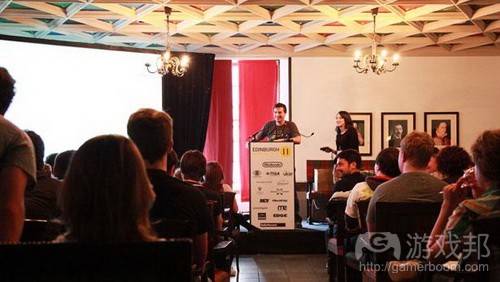游戏化适用各个领域 丰富体验内容
作者:Phill Cameron
过去1年来,游戏化已成为定义最模糊的专业术语;这是个非常笼统的词语,能够指代所有内容,从应用至现实生活的游戏机制和法则到……?游戏化所指飘忽不定,朦胧模糊,其定义最近才开始成形。
在日前的爱丁堡Interactive大会,来自PlayGen的Kam Star和James Allsopp一袭实验袍现身舞台,因为他们是游戏化的分析专家。PlayGen(游戏邦注:该公司自称是“严肃游戏和游戏化开发工作室”)和英国国防部和教育系统达成合作关系,虽然其“游戏化”国防预算的想法令人有些担心,但他们自己却信心满满。
公司首席游戏主管Star称,“此刻我们大家都在进行游戏。我们所开展的各种活动都有些许游戏色彩。”
本质来看,游戏化在Foursquare之类的内容就体现得非常明显,其中用户的基本活动都转化成积分和成就。频繁访问某地方,你就能够成为当地的“mayor”,若你不够警惕,随时有可能被另一频繁访问者取代。随之而来的问题是什么玩家配当“mayor”,但这并不重要。这不过是给访问咖啡厅之类平凡活动的增添“游戏色彩”。
其背后的理念就是在我们原本不感兴趣的内容中融入游戏机制,旨在通过这些机制吸引我们。在某地点附着最高分数能够促使你更常访问该地点(游戏邦注:只要你希望获得这些积分)。若在假期村庄探索活动中融入某种“奖励”,内容将变得更有趣。
或者用Star的话来说,“我们都在玩关系游戏;你的床柱有几个凹位?我们在Facebook积累朋友。他们是个商品。”
这或许有些不够正经,但也能够得分。虽然游戏化并不一定是个杰出概念,但它却能够把我们的内在竞争本性同日常生活密切联系。移动设备和互联网的普及令这些数据能够存储于排行榜,以数字形式呈现,在你通过手机或电脑登陆应用时向你呈现。
这些机制大多只是通过游戏形式化。最高分数只是把社交或身体优越性变成有形物体。称易趣和Allsopp一样也是款游戏似乎是个无意义的推断,因为《魔兽世界》也有拍卖行。同样,称自己能够通过游戏化促使Facebook用户互相竞争和吹嘘好友数量听起来有些空洞。玩家很早就开始互相炫耀好友数量。你无需将此形式化。
Star称“积分是游戏化的基础,缺乏真实得分基础的积分就毫无意义。”
他完全正确,这是要点。游戏化非常新颖,所以关于要把哪个游戏内容移植和转化到真实世界自然会出现过失。将分数融入健康减肥或通过税收评级效率确实适合某些人。
在发言中,二人通过一副自制扑克牌制作观众提议的游戏主题(游戏邦注:提议内容涉及民间动乱,消除暴动动机和成功条件,以及融入游戏机制和社交互动)。这是个好主意;将游戏元素融入单纯基本要素中,然后把它们转换成无需控制台的内容。问题是什么要素才是根本要素,哪些能够顺利同游戏内容区分开来。
Star接着表示,“游戏和玩法具有3大特性:吸引力,回报性和粘性。”
这些是游戏的基本要素。它们也是众多内容的基本要素,但对那些缺乏此要素的内容,你可以借助游戏化概念令其变得富有吸引力、回馈性和粘性。这就是游戏化背后的理念。这就是为什么各公司如此兴奋;忽然之间他们又找到新途径进一步吸引用户眼球。现在用户可以同他们进行互动。
“我觉得玩法要能够激起情绪回应。这不局限于趣味,其比趣味更广泛。你可以通过游戏把内容变得更有趣。”
这是游戏化的关键。其通过基本游戏机制吸引用户,吸引他们的好友。若某公司能够掳获你其中一位好友,即便只是5分钟的投入和成就,他们就能够向你展示内容,更快吸引你的眼球。你对产品不感兴趣没有关系;你至少会看一看。你通过游戏化取得的成就更多。游戏化在营销方面的表现是10分。(本文为游戏邦/gamerboom.com编译,如需转载请联系:游戏邦)
PlayGen: Gamification Can Bring A ‘Gaming Layer’ To Everything We Do
by Phill Cameron
Over the past year or so, gamification has become a buzz word defined, in most, by only the vaguest of terms; a catch-all term that can mean nearly anything, that of applying game mechanics and principles to real life, to the end of… what, exactly? It’s floated around, nebulous and imprecise, with its definition only now starting to take form.
At the Gamasutra-attended Edinburgh Interactive today, PlayGen’s Kam Star and James Allsopp stand on the stage in lab coats, because they’re gamification’s equivalent of rocket scientists. PlayGen, a self-described “serious games and gamification development studio,” works with the Ministry of Defense and education system in the UK, and while the thought of “gamifying” our defense budget is mildly worrying, they’ve certainly got confidence in the idea.
“We’re all gaming right now,” chief play officer Star begins, an opening salvo worth three points. “There’s some sort of gaming layer that we’re all playing.”
In its basic essence, gamification is obvious in something like Foursquare, where people’s basic movements are translated into points and achievements. Hang out in the same place enough, and you become “mayor” of that area, to be dethroned by another frequent visitor if you’re not vigilant. Of course the question of what worth being “mayor” is arises, but that’s not important. It’s a “gaming layer,” placed upon something as mundane as visiting a coffee shop.
The idea behind it is to take something that we might not otherwise be interested or engaged in and attach game mechanics onto it in an effort to draw us in through those systems. Attaching a high score to a location will make you visit that location more, so long as you want those points. Exploring a country on your holiday can be made a more interesting activity if there’s some sort of “reward” for doing so.
Or, to put it in Star’s words, “We’re playing the relationship game; how many notches on your bedpost? We’re collecting friends on Facebook. They’re a commodity.” One point for the frivolous treatment of human beings.
Tongue-in-cheek as it may be, there’s a point here. And while it’s not necessarily that gamification is a concept with merit, there is definitely something in tying our inherent competitive nature into our everyday lives. And the prevalence of mobile devices, coupled with the internet, allows such data to be digitized and stored in leaderboards, shown to you when you sign into the apps on your phone, or even on your desktop.
“Your bank balance is your high score.” Two points for truth.
A lot of these systems were merely formalized by games. The high score is just turning social or physical supremacy into a tangible thing. Claiming that eBay is a game, as Allsopp does, because World of Warcraft has an auction house, seems a pointless recursion. Similarly, claiming that you can make people compete and brag about how many friends they have on Facebook through gamification rings hollow. People are already bragging about how many more friends they have than one another. You don’t need to formalize it.
“Points are the cornerstone of gamification,” Star counters with, scoring five points for prescience. “Points without a real point are pointless.”
He’s right, of course, which is the point. Gamification is something so new that of course there’s going to be missteps on which particular parts of the game to reappropriate and translate into a real world environment. Incorporating a score into weight loss or rating how efficient you are with your taxes can really work, with the right kind of person.
During the presentation, the pair use a pack of playing cards of their own devising to create a game from the crowd-suggested topic of civil unrest, working through motivation, victory conditions, game mechanics and social interaction. It’s the right idea; boiling gaming down to the bare basics, then converting them into something you don’t need a console for. The problem lies in which basics really are the fundamentals, and which of them can be successfully separated from the games.
“There are three reasons for games and play,” Star continues, scoring three points, just ’cause. “They are compelling. They are rewarding, and they are engaging.”
Those are the basics of games. They’re also the basics of a great deal of things, but for those that they’re not, you can use the idea of gamification to make something compelling, rewarding and engaging. That’s the idea behind it. That’s why companies are excited; suddenly they’ve got a way to lure consumers in on a whole new level. Now the consumers can interact with them.
“I think gameplay should always elicit an emotional response.” Another point for truth. “It’s not just fun. It’s much much bigger than just fun. You can use the game as a leverage to make it more interesting.”
That’s the crux of it, there. It’s about drawing people in with basic game mechanics, and drawing in their friends, too. If a company can take a little part of one of your friends, even if it’s just five minutes of their time and an achievement, they can show that to you, and pull you in that much quicker. Doesn’t matter that you’re not interested in the product; now you’ll at least have a look at it. That’s more than you would’ve done without gamification. Gamification gets 10 points from marketing.(Source:gamasutra)








































 闽公网安备35020302001549号
闽公网安备35020302001549号